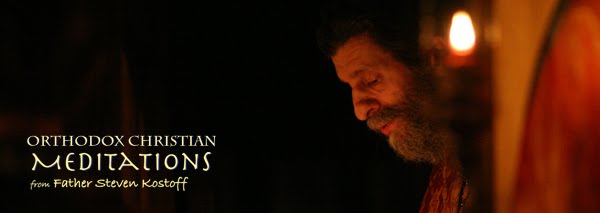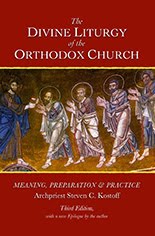 |
| Fr Roman, Mother Abbess Gabriela (w/pectoral cross) and the sisterhood with the new church under construction in the background. |
Dear Parish Faithful,
The monastery was founded by three
nuns from Romania, in a desire to pursue missionary work and spread
Orthodoxy further into America. This vision had to be fulfilled
through a monastic structure; not by importing or recreating a glorious
past, but by drawing on the traditions of the past that keep alive the
Orthodox faith.
(The
nuns of the monastery)
By the grace of God,
presvytera Deborah and I, together with fellow-parishioners Jennifer Haynes and
Amanda Wheelock, were able to travel to Rives Junction, Michigan, for the
consecration of the new church at the Dormition of the Mother of God Monastery
which has been located there since 1987.
Hence, the consecration of the new church coincided with the 25th
anniversary of the monastery’s establishment.
I am not able to estimate crowd sizes very well, but together we guessed
that there were around five hundred faithful – clergy and laity – assembled
together for the event. It was a
memorable event for the nuns of the monastery , and we rejoice that we were
able to participate in the consecration/celebration together with them. The beautiful natural setting of the
monastery; the warm embrace of the mothers and sisters; and the spontaneous
fellowship with one’s fellow pilgrims increased that sense of rejoicing
threefold. It was good to be there!
Having arrived well
into the evening on Friday – just about when the Vigil was drawing to a close –
we were up bright and early for the cycle of services that would mark the consecration itself. There was a definite splendor and liturgical
fullness to the Service of Consecration and the Divine Liturgy to follow, for
there were four bishops con-celebrating – led by Archbishop Nathaniel – about
twenty-five priests and six deacons, and a host of sub-deacons and other
servers. The mothers and sisters of the monastery provided the choir, together
with other visiting nuns and monks. From
the initial procession of the holy relics from the old chapel to the courtyard
of the new church, through to the dismissal of the Liturgy, the services
stretched over a five-hour period. Orthodox
stamina, developed over years of liturgical experience, served everyone very
well, for clergy and laity alike stood throughout the services. I was invited to serve and brought along my
vestments. However, one thing caught me
off-guard, so to speak, and tested whatever stamina I may have had to the
full. Except for the consecration of the
altar table and the interior of the new church, we were outdoors for at least
four of those five hours – and the temperature in Michigan probably did not
reach 50 degrees on Saturday! Clergy
vestments can be burdensome on a hot summer day; but they provide scant
protection from a chilly day outdoors. Mercifully,
it was not a windy day, but even the slightest breeze seemed to penetrate to
the bone, and thus remained most unwelcome.
We were all in it together, and that collective effort was most helpful.
Still, it was indeed a challenge to remain attentive and prayerful, when
thoughts of endurance impinged upon the mind!
However, in addition
to the intense and expressive prayer that so characterizes Orthodox worship,
the mind could find rest elsewhere on this crisp Fall day. I briefly alluded to the beautiful natural
setting of the monastery in south central Michigan, and it would be difficult
to over-emphasize that beauty which is intensified precisely during the Fall. Though located near a country road that has
its periodic traffic, the monastery has a definite rural setting that already
in itself is a relief from the urban setting most pilgrims briefly leave
behind. We fail to realize the extent to
which one can miss a peaceful environment until you are in the midst of one.
The clusters of magnificent trees that collectively stretch as far as the eye
can see, resplendent with a variety of vivid and vibrant Fall colors – flaming
red, bright orange and golden yellow - not only surround the monastery grounds
but seem to enfold those grounds with a protective embrace. In some mysterious manner, one can sense the
participation of the natural world in the ongoing prayer of the monastery that
in turn hallows those grounds. With its
well-tended gardens and flower beds thoughtfully placed throughout the
monastery, the nuns manifest a deep respect and sense of stewardship for the
world of nature that we can easily lose sight of. Here, that intuitive longing
for the restoration of harmony between God, human beings and the natural world
seems to be within one’s grasp. “O Lord, how manifold are Thy works; in
wisdom has Thou made them all!
The new church now
stands at the very center of the monastery grounds as it will be at the center
of the spiritual life of the community, filled with daily prayer rising to God
as incense in His sight. Further, it is now at the center of that protective
embrace of the natural world described briefly above. In that setting there is a real grandeur and
beauty about it. The new church at the Dormition Monastery was designed in that
unique style that is characteristic of Romanian Orthodox church architecture, I
believe going back well into the medieval period of that country’s Orthodox
Christian history. This is a beautiful temple truly raised to the glory of
God. It has been constructed and adorned
with great care and love. The interior
is decorated with fine examples of classical Byzantine iconography. It is that
“sacred space” that is consecrated – offered to God – as the dwelling place of
God that also serves as a foretaste of the beauty of the Kingdom of
Heaven. It is thus a fine example of
that Orthodox intuition of the saving power of beauty. There are some “finishing touches” yet to be
completed, so I eagerly anticipate my next return visit to the monastery to see
the church in an even more completed form.
The consecration of
a new church can be a rare experience for many of the faithful. It is an elaborate service that is comprised
of processing around the new temple three times with the holy relics that will
eventually find their resting place in the new altar table, accompanied by
prayer and scriptural reading before actually entering the church. Once inside the church, the concentration is
on the new altar table that is essentially “baptized” – or “consecrated” - by
being washed with holy water and anointed with blessed oil. The holy relics are then sealed with a hot
wax into the new altar table and the altar table is “robed” or “vested” with a
beautiful new cloth prepared for that purpose.
The walls of the church are also anointed with a blessed oil and
sprinkled with holy water. But there was
one very special event that was certainly a splendid “surprise” for many of the
faithful. According to what I was told
was a Romanian tradition, every person present at the consecration – men, women
and children – were blessed to enter into the sanctuary behind the iconostasis,
and encircle the newly-consecrated altar table.
Since women are not usually blessed to enter the sanctuary – except for
those with a special blessing, usually within a monastic community – this was
indeed a unique opportunity. Presvytera Deborah was deeply moved by the
experience. It was the first time she
had been blessed to enter the sanctuary in her entire life.
At the banquet to
follow, Fr. Roman spoke of the role of the monastery within the life of the
Church at large. He reminded us that the
monastery is not “owned” by the nuns.
Their names do not appear on any of the property deeds. The monastery is open to any of the faithful,
or to any interested inquirers into the Orthodox Faith or monastic tradition. As the beautiful new brochure that serves to
introduce the monastery to the outside world simply states: “The first major activity of the monastery
after prayer is hospitality. St. Paul
says: Do not forget to entertain strangers, for by so doing some have
unknowingly entertained angels.” (HEB. 13:2) The monastery thus belongs to the Church –
the living and breathing People of God who comprise the one Body of Christ, in
service to the one Head – our Lord Jesus Christ.
This is the perfect
place to retreat to even if briefly. The
Dormition of the Mother of God Monastery will remind of us are calling and
vocation as Christians in a world filled simultaneously with both temptations to
abandon our vocation and inspiration to fulfill that vocation with ever-greater
commitment and intensity. Our parish of
Christ the Savior/Holy Spirit Orthodox Church has established a strong bond
with Mother Gabriela and the other mothers and sisters of the community. We are fully committed as a parish to
continually strengthen that already-existing bond. Participation at this last weekend’s
consecration of the new church there by a representative group from our parish
was one more step toward that goal.













